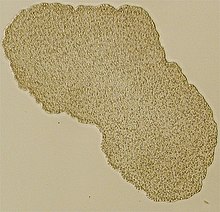| Trichoplax | |
|---|---|

| |
| Light microscope image of Trichoplax (specimen ca. 0.5 mm across) | |
| Scientific classification | |
| Domain: | Eukaryota |
| Kingdom: | Animalia |
| Phylum: | Placozoa |
| Class: | Uniplacotomia |
| Order: | Trichoplacea Tessler et al., 2022 |
| Family: | Trichoplacidae Bütschli & Hatschek, 1905 |
| Genus: | Trichoplax Schulze, 1883 [1] |
| Species: | T. adhaerens
|
| Binomial name | |
| Trichoplax adhaerens Schulze, 1883
| |
| Synonyms | |
| |
Trichoplax adhaerens is one of the four named species in the phylum Placozoa. The others are Hoilungia hongkongensis, Polyplacotoma mediterranea and Cladtertia collaboinventa. Placozoa is a basal group of multicellular animals, possible relatives of Cnidaria.[2] Trichoplax are very flat organisms commonly less than 4 mm in diameter,[3] lacking any organs or internal structures. They have two cellular layers: the top epitheloid layer is made of ciliated "cover cells" flattened toward the outside of the organism, and the bottom layer is made up of cylinder cells that possess cilia used in locomotion, and gland cells that lack cilia.[4] Between these layers is the fibre syncytium, a liquid-filled cavity strutted open by star-like fibres.
Trichoplax feed by absorbing food particles—mainly microbes—with their underside. They generally reproduce asexually, by dividing or budding, but can also reproduce sexually. Though Trichoplax has a small genome in comparison to other animals, nearly 87% of its 11,514 predicted protein-coding genes are identifiably similar to known genes in other animals.
- ^ M. Eitel (2011). Schierwater B, Eitel M, DeSalle R (eds.). "Trichoplax Schulze, 1883". World Placozoa Database. World Register of Marine Species. Retrieved 25 November 2011.
- ^ Laumer, Christopher E.; Gruber-Vodicka, Harald; Hadfield, Michael G.; Pearse, Vicki B.; Riesgo, Ana; Marioni, John C.; Giribet, Gonzalo (2018). "Support for a clade of Placozoa and Cnidaria in genes with minimal compositional bias". eLife. 7. doi:10.7554/eLife.36278. PMC 6277202. PMID 30373720.
- ^ Osigus, Hans-Jürgen; Eitel, Michael; Horn, Karolin; Kamm, Kai; Kosubek-Langer, Jennifer; Schmidt, Moritz Jonathan; Hadrys, Heike; Schierwater, Bernd (2022). "Studying Placozoa WBR in the Simplest Metazoan Animal, Trichoplax adhaerens". Whole-Body Regeneration. Methods in Molecular Biology. Vol. 2450. pp. 121–133. doi:10.1007/978-1-0716-2172-1_6. ISBN 978-1-0716-2171-4. PMC 9761494. PMID 35359305.
- ^ "Introduction to Placozoa". Archived from the original on 25 March 2018. Retrieved 4 October 2015.